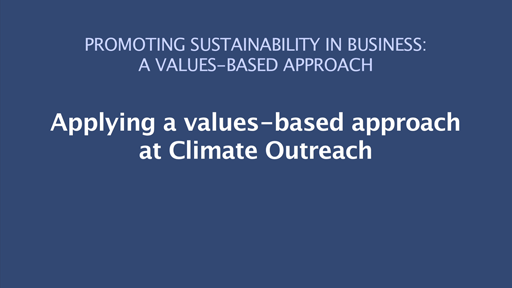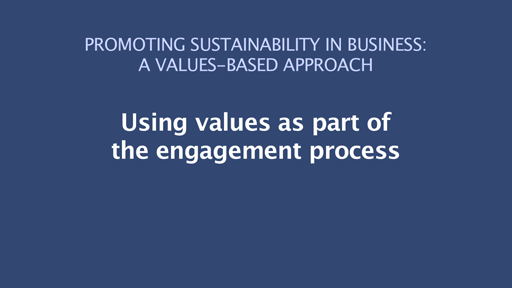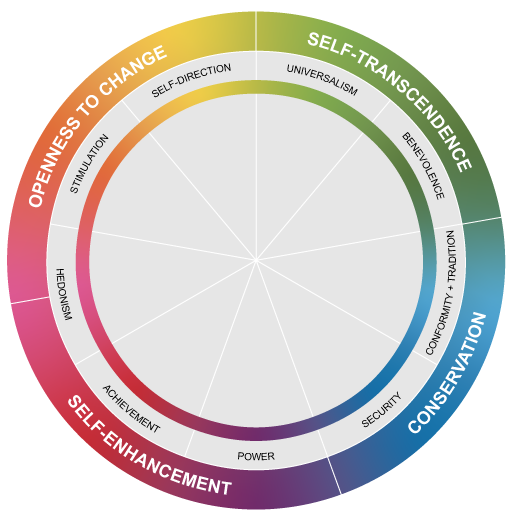Use 'Print preview' to check the number of pages and printer settings.
Print functionality varies between browsers.
Printable page generated Monday, 1 December 2025, 11:52 AM
3 A values-based approach to engagement (1/2): concepts
3 A values-based approach to engagement (1/2): concepts
A person’s attitudes about a particular issue, such as smoking in public places, can change quite dramatically over time. In the world of politics, people may switch their allegiances between different parties or candidates; people may also present quite distinct ‘selves’ in work and social situations, and with different groups of people. However, one aspect of a person’s psychological make-up is thought to be relatively consistent and is at the core of their identity: personal values.
Most people have an intuitive sense of what personal ‘values’ are, but the typical academic definition, of a ‘guiding principle in the life of a person’, provides a good starting point. Our personal values have a strong influence on some of the most important decisions we make: what we choose to study, what career we pursue, and how we raise our children. They are also important influences on the way that we respond to social and environmental issues, including climate change.
In this session, we take a brief overview of some key ideas about values, with a particular focus on the way they affect the relationship between business owners, managers and advisors.
Values in the workplace
When it comes to engaging with business, we can encounter values from three distinct sources. Each individual’s personal values interact with other sets of values, associated with their type of job role that they undertake and with the organisation in which they are working (Figure 1). Click on each source to see the values they represent.
Figure 1 (interactive) Values in the workplace
These three sources of values are constantly interacting. For some individuals the three sets of values might be in perfect alignment, while for others there may be conflicts and tensions at play. These can make it difficult for advisors coming from outside. Nonetheless, understanding the values of your audience, and tailoring your message to speak to those values, can help advisors to be more effective in their work.
 Thinking point
Thinking point
How do these three sources of influence – organisation, job role and personal – affect you in your own life? Do you agree with the idea that individuals can only have job satisfaction if the values from each of these sources are aligned?
3.1 The ‘values-based’ approach
Activity 3.1: Introducing the values-based approach
Chris responds to the final question: ‘How can you use language to connect with the values that really matter to people?’ in the following video extract (around 1 and a half minutes):

Transcript
Connecting to values that matter
[MUSIC PLAYING]
[How can you use language to connect with the values that really matter to people?]
[MUSIC PLAYING]
Discussion
In the video, Chris explains how Climate Outreach uses a values-based approach to engage with different groups of people, including some that are normally resistant to messages about environmental issues, including climate change. He stresses how important it is to use the right language if you want to these people to take your message seriously. This is because some words, phrases and images are consistent with the values that really matter to people, while others are either less relevant or even contradictory.
Business advisors and clients may draw on different types of personal values, however, it is possible to overcome these differences through a careful use of language. In this short follow-up video, Chris offers a practical example of how you might connect with a particular audience by drawing on appropriate language and imagery.
3.2 The Theory of Basic Human Values
The second activity in this session introduces research based on the work of a prominent psychologist, Shalom H. Schwartz, which analyses human values.
Activity 3.2: Introducing the Theory of Basic Human Values
Shalom H. Schwartz is an Israeli social psychologist who has conducted extensive quantitative research on human values across the world.
The Theory of Basic Human Values is based on surveys conducted with over 60,000 people, and posits that there are 10 distinct, universal values. In turn, these are categorised into four higher-level groups:
Openness to change
- Self-direction – Motivations include independent thought and action. Individuals value choice, creativity, exploration.
- Stimulation – Motivations relate to innovation, excitement and overcoming challenges.
Self-enhancement
- Hedonism – Individuals who derive motivation from pleasure or sensuous fulfilment.
- Achievement – Personal success through demonstrating competence according to social standards.
- Power – Relates to having social status and prestige, control or influence over people and resources.
Conservation
- Security – Individuals tend to prioritise safety and stability.
- Conformity – Motivated by social acceptance, including restraint of actions, inclinations, and impulses likely to upset convention.
- Tradition – Respect, commitment, and acceptance of the customs and ideas that one's culture or religion provides.
Self-transcendence
- Benevolence – Preserving and enhancing the welfare of those with whom one is in frequent personal contact.
- Universalism – Understanding, appreciation, tolerance, and protection for the welfare of all people and for nature.
Other
- Spirituality was initially considered as an additional eleventh value in an earlier version of the theory. However, based on surveys across different cultures, it was found not to exist everywhere.
Activity 3.3: Making sense of Schwartz
- Which of the following Schwartz values do you most associate with SMEs?
- Self-direction
- Stimulation
- Hedonism
- Achievement
- Power
- Security
- Conformity
- Tradition
- Benevolence
- Universalism
Answer
Given what we know about the extreme heterogeneity of the SME population, it is too simplistic to attribute particular sets of values to SMEs. The organisational values of small organisations can be as varied as they are for individuals.
However, this question reveals some interesting insights from course participants (including you) about the values they associate with the businesses they have worked with.
The Theory of Basic Human Values will be revisited later, when you will get a chance to use the diagram interactively.
 Thinking point
Thinking point
We have seen how the Schwartz Theory of Human Values identifies different types of values, and have started to look at how the personal values held by SME owners, managers and even business advisors might vary. We have also noted that organisations may be associated with a particular set of values, adding further to the complexity of the situation.
Watch this short video (4 minutes) in which several business advisors describe how they currently make use of values when they are working with clients.

Transcript
Using values as part of the engagement process
[MUSIC PLAYING]
[How do you make use of values in your day-to-day work?]
[MUSIC PLAYING]
How might you take these different personal and organisational values into account in your own working practice?
Summary and action points
In this session we have described how values come into play in the workplace from a range of sources.
We heard about how Climate Outreach use values to engage different segments of the public on the issue of climate change. They have identified particular messages that speak to the values held by faith groups or the centre-right.
We also introduced the Theory of Basic Human Values, based on work in social psychology.
You should now be able to:
- Reflect on the values that you encounter in your own workplace.
- Consider how organisational, professional and personal values can be variously aligned or in conflict.
- Predict how attitudes towards environmental issues are likely to be influenced by different basic human values.
You have now completed Session 3.
